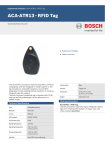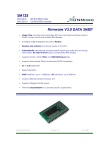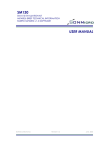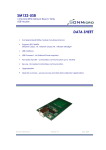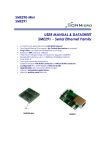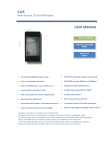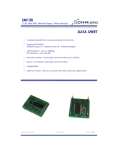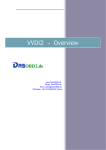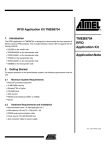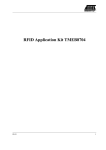Download SM125 System USER MANUAL
Transcript
SM125 System SM125-IC 125 KHz RFID Chip SM125-M1 125 KHz RFID Module SM125-EK Evaluation Kit SMRFID 3.0 Software USER MANUAL SonMicro Electronics Revision A.1 May, 2008 2 SM125 User Manual 1. INTRODUCTION 4 1.1 125 KHz RFID Systems 5 1.2 Evaluation Board Layout View 6 1.3 SM125-EK / SM4005 Schematic 7 2. FAST STARTING GUIDE – SETUP & GO 8 2.1 Setup Auto Mode 8 2.2 Setup Data Output 9 3. THEORY OF READ OPERATION 10 3.1 Manchester Modulation 10 3.2 Byte Track Method 10 3.3 EM4102 Mode 12 4. READING THE TAG 13 4.1 Read Command 13 4.2 Stop Read Command 14 4.3 Auto Mode 14 5. DATA OUTPUT SETTINGS 15 5.1 UART Serial 15 5.2 Wiegand 26 Bit 15 5.3 Output0 15 6. TAG PROGRAMMING 16 7. CALIBRATION 18 8. OVERVIEW OF OTHER COMMANDS & SETTINGS 20 8.1 Byte Track Settings 20 8.2 I2C Settings 20 8.3 Tag Programming Parameters 20 8.4 Change Baud Rate 20 8.5 Get SM125 Configuration 20 SonMicro Electronics Revision A.1 May, 2008 3 SM125 User Manual 8.5 Software Reset 20 8.6 Sleep 20 8.7 Read Input0 20 8.8 General Purpose Output Control 20 9. SALES AND SERVICE INFORMATION SonMicro Electronics Revision A.1 21 May, 2008 4 SM125 User Manual 1. INTRODUCTION SonMicro’s primary products for 125KHz RFID is the SM125-IC chip and the SM125-M1 modules. To evaluate, test, demonstrate or develop any application with the SM125 devices, the best, painless and the quickest way is to obtain a low cost SM125-EK Evaluation Kit. SM125-EK together with the SMRFID V3.x Software is just everything the users need. SM125-EK kit includes evaluation board, module, tags and antennas. SM125-EK is a professional evaluation kit for SM125-M1 modules. The kit includes power supply for the module, RS232 connection, I2C pins, LCD connector, and the antenna connector. SM125-EK communicates with PC over RS232 (DB9 female jack) serial port (USB-to-Serial converters works fine) at different baud rates from 9600bps to 115200bps (19200bps default). SM125-M1 module can also communicate with external peripheral over I2C bus with the provided I2C pins on the kit. For latest Documentation & Software: http://www.sonmicro.com/125/d125.php For World Wide Online Store: http://www.sonmicro.com/shop/shop3.php Figure 1 – SM125-EK-D Evaluation Kit Photo SonMicro Electronics Revision A.1 May, 2008 5 SM125 User Manual 1.1 125 KHz RFID Systems SonMicro’s solution for 125 KHz RFID is unique in the world. The SM125-IC chip includes both RFID analog system and microcontroller in the same package. Competitors offer only the analog chip and left the complicated decode operations to the user to be done by the external microcontroller. The most used applications for the 125 KHz RFID systems is in general the person identification, specifically access control, time & attendance systems, and the part identification i.e. the immobilizer systems used in automotive applications. The read range in a 125 KHz RFID system is generally between 5 – 15 centimeters, typically 8cms (~3.5 inches). The read range varies according to the antenna size, tag size, shape and the material. For example the clamshell cards, a bit thicker than ISO cards, have better performance than ISO cards, where TK type (i.e. TK5551, TK5530) 2-3 mm sized tags have low performance. The most popular tag used in 125 KHZ RFID systems, generally called EM, is EM4102 readonly tags. These tags have less cost and are ideal for person identification. T5557, or Q5 (T5555) re-writeable tags have also pie in tag market. The most popular modulation is the Manchester RF/64 type modulation. The other modulation types such as FSK, PSK have very specific application and are not widely used. FSK and PSK is not supported by SM125 devices. SonMicro developed SM125 devices according to the most used standards explained above. 125 KHz RFID advantages over 13.56MHZ RFID - Reader components such as IC, module is significantly cheaper Better performance behind the metallic objects. Cheaper tags can be found such as EM4102 125 KHz RFID disadvantages over 13.56MHZ RFID - Less secure than 13.56 MHz - Writing to tags continuously for data storage is not practical and slow. SonMicro Electronics Revision A.1 May, 2008 6 SM125 User Manual 1.2 Evaluation Board Layout View Figure 2 – SM125-EK-D Evaluation Board Description SonMicro Electronics Revision A.1 May, 2008 7 SM125 User Manual 1.3 SM125-EK / SM4005 Schematic SonMicro Electronics Revision A.1 May, 2008 8 SM125 User Manual 2. FAST STARTING GUIDE – SETUP & GO This section is prepared for those who want to make a very fast starting without investigating SM125 usage details. The following example is given to read EM4102 tags, and output the EM4102 data as ASCII characters with Carriage Return (CR) and LF (Line Feed) characters. The example is chosen for the most used operation in the field. Once the following “Auto Mode” and “Data Output” settings is done then the SM125 will act with the same settings even after Power-On-Reset because the necessary settings is stored in flash memory of SM125 and they are loaded each time after reset. 2.1 Setup Auto Mode - Connect the SM125-EK to the PC and open SMRFID v3.x software. - Select the appropriate port and 19200bps - Select the EM4102 parity decoded option in the main window - Uncheck Send Password - Select 2 for Number of Blocks to be Read - Select Enable and click on “Set Auto Mode”. You should see “RX> Success” in the Comport Activity and Information Box. Figure 3 – Setup Auto Mode SonMicro Electronics Revision A.1 May, 2008 9 SM125 User Manual 2.2 Setup Data Output User can determine output behavior for a successful read operation. In our example, we will use ASCII character output with CR and LF footer characters. - Open SMRFID>Settings>Output Settings Check UART/Serial Select Simple ASCII Check CR and LF footers Click on “Set Output Parameters” . You should see “ RX> Success” Figure 4 – Setup Data Output Behavior Now, whenever you place EM4102 tag near antenna, SM125 will read it automatically and send as tag data as ASCII characters with CR+LF footers. SonMicro Electronics Revision A.1 May, 2008 10 SM125 User Manual 3. THEORY OF READ OPERATION There are two options for the read operation according to the modulation and the method used in the tag. 3.1 Manchester Modulation SM125 supports Manchester RF/64 and Manchester RF/32 modulations in the V3.0x firmware. The Manchester RF/64 is the most used modulation type in 125 KHz systems and is recommended to be used for new designs. Manchester RF/32 is used in some tags (e.g. TK5552) but the read performance is lower than the Manchester RF/64 and not recommended for new designs. For Manchester RF/64, signal representing 1 or 0 is in 512us width for 125 KHz. For Manchester RF/32, signal representing 1 or 0 is in 256us width for 125 KHz. EM4102 tags use Manchester RF/64 modulation and EM method and the configuration of these read-only tags is fixed and can’t be altered. T5557/T5555/Q5 re-writeable tags that are delivered by SonMicro are configured for Manchester RF/64 modulation and “Byte Track” method. Note that T55xx tags purchased from other resources can be configured for different modulation and methods. 3.2 Byte Track Method Whether the modulation is Manchester RF/32 or Manchester RF/64, when the tag is energized in the magnetic field across the antenna, tag will be sending data consist of 1s and 0s continuously with no break or no sign for the header. To detect the start sequence of the incoming data there are two methods. One is the “byte track” method and the other is “EM” method. If “Byte Track” is used, SM125 device tracks 4 byte; 0x52 0x58 0x8B 0x45 as default. These settings can be changed. SM125 device can trace for 1 byte, 2 byte, 3 byte or 4 byte. The most reliable and recommended option is to trace for 4 byte. Note that the traced bytes should not repeat elsewhere in the incoming data stream, otherwise the header/block1 synchronization can be wrong. Please note that, if the tag does not include bytes to be traced, then that tag can not be read. T555x re-writeable tags needs to use Byte Track method and so the first block needs to be written/programmed with the bytes to be traced. There is a way to program T555x transponders acts as an EM4102 tag, but this is explained in another application note. Incoming and continuous data stream from the tag: 11110000011100100…0101 0010 0101 1000 1000 1011 0100 0101…000111010010011111001 0x52 0x58 0x8B 0x45 T555x Tags send data as follows: (Example is given for 3 blocks is transmitted by the tag. Each block has 4 byte data) … Block1 Block2 Block3 Block1 Block2 Block3 Block1 … Block1 should be programmed with 0x52 0x58 0x8B 0x45 so that when SM125 catch these bytes, it will be synchronized and assume 0x52 0x58 0x8B 0x45 as the first block. If Block1 is programmed with another traceable bytes, then these new bytes should be configured in SMRFID>Settings>Byte Track Settings window. SonMicro Electronics Revision A.1 May, 2008 11 SM125 User Manual T555x re-writable tags delivered by SonMicro comes with the following data programmed Block No Block Description Programmed Content 0 Configuration Block 60 01 F0 0E 1 Data Block / Trace-able Block 52 58 8B 45 2 Data Block 02 02 02 02 3 Data Block 03 03 03 03 4 Data Block 04 04 04 04 5 Data Block 05 05 05 05 6 Data Block 06 06 06 06 7 Data Block / Password Block 00 00 00 00 Table 1 – T5555 (Q5) Tag Content Notes: Block 0 60 01 F0 0E corresponds to Manchester RF/64 , transmit of 7 block (Block1..7) Block0 should not be programmed with arbitrary values otherwise the tag may not be accessed again. Please use SMRFID>Tools>Tag Programming to determine block0 data. Block 1 This block can be used for “Byte Track” method. What is programmed in this block should be traced by SM125. Block 2-6 General purpose data bock. Writing to this block is safe. No care required. Block 7 This block can be used as general purpose data block or can be used as password. If password is enabled, access to the tag requires the password that matches block7 content. Once password is enabled and if the block7 data is unknown then it is impossible to access the tag again unless with the correct 4 byte password. Block No Block Description Programmed Content 0 Configuration Block 0014 80 E0 1 Data Block / Trace-able Block 52 58 8B 45 2 Data Block 02 02 02 02 3 Data Block 03 03 03 03 4 Data Block 04 04 04 04 5 Data Block 05 05 05 05 6 Data Block 06 06 06 06 7 Data Block / Password Block 00 00 00 00 Table 2 – T5557 Tag Content Notes: Block 0 00 14 80 E0 corresponds to Manchester RF/64 , transmit of 7 block (Block1..7) Block0 should not be programmed with arbitrary values otherwise the tag may not be accessed again. Please use SMRFID>Tools>Tag Programming to determine block0 data. Block 1 This block can be used for “Byte Track” method. What is programmed in this block should be traced by SM125. Block 2-6 General purpose data bock. Writing to this block is safe. No care required. Block 7 This block can be used as general purpose data block or can be used as password. If password is enabled, access to the tag requires the password that matches block7 content. Once password is enabled and if the block7 data is unknown then it is impossible to access the tag again unless with the correct 4 byte password. SonMicro Electronics Revision A.1 May, 2008 12 SM125 User Manual 3.3 EM4102 Mode Whether the modulation is Manchester RF/32 or Manchester RF/64, when the tag is energized in the magnetic field across the antenna, tag will be sending data consist of 1s and 0s continuously with no break or no sign for the header. To detect the start sequence of the incoming data there is another method called “EM4102” method. This method is used in EM4102 tags and generally uses Manchester RF/64 modulation. In this mode, instead of tracing bytes explained in section 2.1, nine 1s (1111 1111 1) are traced to detect the beginning of the data sequence. Moreover the data written in the tag is created with parity bits so that even a tag has nine 1s, the read operation will not be successful if the parities do not match. EM4102 tags consist of 2 blocks each have 4 byte. These 8 bytes include nine 1s, actual data that is the 5 byte identification code and the row and column parity bits. 1111100100…1111 1111 1…000111010010011111001 Header Parity coded data EM4102 tag sends data as follows: … Block1 Block2 Block1 Block2 … Please note that, the actual identification code is 5 Bytes in EM4102 tag. With the nine ones and parity bits the raw data is two blocks each 4 byte. Parity check will be done by SM125 automatically and if parity bits do not match then there won’t be any output and SM125 keep trying to read. To get the actual 5 byte data, use “EM4102 decoded” option. To get the raw data including nine ones and parity bits use “EM4102 raw data” option. SonMicro Electronics Revision A.1 May, 2008 13 SM125 User Manual 4. READING THE TAG Reading can be initiated by UART/I2C command or, can be automated if Auto Read mode is used. For most systems, auto mode is recommended so that system may not require any external microcontroller. Once auto mode is setup, module will read and output tag data whenever is available. The tag data will be outputted only one time while the tag is in the magnetic field across the reader antenna. Figure 5 – SMRFID – Read Panel Please note that if the SREAD LED on the kit is ON, and then it means the read operation is active and SM125 is seeking for tag. While there is a valid tag in the field that matches read settings, TAGF will blink. For the tags delivered by SonMicro: For EM4102 tags, use EM4100/02 parity decoded or the EM4102/raw option For T555x tags, use the Byte track Manchester RF/64 option. 4.1 Read Command This command initiates a new read operation with the selected parameters. User can select Read Type, number of blocks to be read, and determine if the read is done by first accessing the tag with a password. If the tag is password protected, please remember that password is the block7 data of the tag. If password option is selected, the SREAD LED will blink around each second indicating the 4 byte password is sent to the tag in each period. For beginners, it is not recommended to protect the tag with a password. Tag may not be accessible again in case of in proper usage. Please note that; If Read is going to be done by Read Command in the system, then it is recommended to disable Auto Read mode. SonMicro Electronics Revision A.1 May, 2008 14 SM125 User Manual 4.2 Stop Read Command This command will stop the read operation. SREAD LED should be OFF after this command is sent. A new read can start only: - if Read command is sent, After Power-On-Reset provided that auto mode was enabled. Enabling auto-mode 4.3 Auto Mode This command enables or disables and sets auto mode parameters. Once the parameters set as in Read Command section, the parameters are stored in the flash memory permanently and the same configuration will be valid until a new setup. User can select the Read Type, number of blocks to be read, and check password box if password is required to access tags. Once parameters are defined, select “Enable” and click on the Set Auto Mode. Now, even after Power-On-Reset, SM125 read operations will be active according to determined parameters and SM125 outputs tag data whenever is available. To disable the Auto Mode, select “Disable” and click on the “Set Auto Mode” button. SonMicro Electronics Revision A.1 May, 2008 15 SM125 User Manual 5. DATA OUTPUT SETTINGS The output behavior of SM125 after a valid tag is read, can be adjusted in SMRFID>Settings>Output Settings. If the existing selections do not meet your requirements, please feel free to contact us for the output selection you require. Figure 6 – SMRFID – Output Settings 5.1 UART Serial In this section, UART/RS232 output can be enabled or disabled and UART/RS232 output behavior can be selected. If Simple ASCII mode is selected, then the bytes in the tag are converted to ASCII characters. For example one byte 0x52 is converted to ‘5’ and ‘2’ two bytes. The Carriage Return (CR) and Line Feed (LF) characters can be added to the end of tag data. 5.2 Wiegand 26 Bit In this section, Wiegand output can be enabled or disabled and the required parameters can be selected. Wiegand 26 bit is consisting of 3 bytes with 2 bits parity. The actual 3 byte, Facility and Identification code can be set easily with flexible options. 5.3 Output0 Output0 can be enabled to be ON for a determined period just after a successful tag read. It is useful to trigger a relay or buzzer just after tag data is read. Please note that external transistor circuit may be required to drive the target component. SonMicro Electronics Revision A.1 May, 2008 16 SM125 User Manual 6. TAG PROGRAMMING To program a re-writeable tag (T555x) open SMRFID>Tools>Program Tag window. Please note that EM4102 tags are read-only and can’t be programmable. Block0 data will automatically be reconstructed according to the parameters chosen. Figure 7 – SMRFID – Writing to Tag Please note that when programming Block0 a special care should be taken. Each tag type has different settings for Block0. Programming Block0 with inappropriate data will cause tag to be useless. Thus when programming Block0, make sure the selected tag in the software and tag to be programmed is the same type. For example, T5551 block0 should not be programmed to Q5 (T5555) block0. Please note that when programming Block1 a special care should be taken. This block is allocated for “Byte Track” mode. This is the only way to read these tags. A known pattern should be captured and then tag can be read. This block is programmed with 0x52 0x58 0x8B 0x45 as default and SM125 tracks for these bytes. If the block 1 content is going to be changed then SM125 Byte Track settings needs to be changed as well for the new traceable bytes Please note that when programming Block7 a special care should be taken if the password is going to be enabled. If password is enabled in block0 configuration, and after block0 is programmed, access to the tag needs to be done with a 4 byte password. The password is 4 byte and the block7 data. Thus user need to know what is written to block7. SonMicro Electronics Revision A.1 May, 2008 17 SM125 User Manual Before programming a tag, if the read operation is active, stop the operation by Stop Read command. The SREAD LED should be OFF. Otherwise the tag programming can be unsuccessful or wrong data can be written to tag which may cause tag to be useless. When programming a tag, the best practice is holding the tag over the antenna about 34 cm (1 – 1.5 inches) distance. While tag is being held over the antenna, click on PRG BLKx buttons to program desired block. Please note that success response does not mean, the tag is programmed successfully but indicates that the tag programming functions called internally and the write sequence has been finished. To confirm the tag is programmed the only way is to read the tag and check the values manually. SonMicro Electronics Revision A.1 May, 2008 18 SM125 User Manual 7. CALIBRATION SM125 modules are calibrated in the factory. However for the tag type and antenna used, calibration may need to be done again for better performance. RADF = Antenna Drive Frequency 12MHz / (RADF+1) 93 will yield = 127.6 KHz 94 will yield = 126.3 KHz 95 will yield = 125.0 KHz 96 will yield = 123.7 KHz 97 will yield = 122.4 KHz 98 will yield = 121.2 KHz Please note that, for best read range RADF should not be necessarily 125 kHz and can vary around 125 KHz. Other parameters are quite technical details which are internal parameters and also there is no linear or mathematical relation that can explain read range according to their values. For your reference, the default parameters used in SM125-IC and module are: RADF: A1: A2: A3: G1: G1: 97 2 3 3 24 24 RADF: A1: A2: A3: G1: G1: 96 3 3 3 24 24 The actual calibration parameters will be programmed to SM125 is found at the right hand side of the window where “SET” buttons and “Set All” button exist. The parameters at the left hand side are the selections that SMRFID software will try each condition. Figure 8 – SMRFID – Writing to Tag To make the calibration automated, place a tag over the antenna with the desired distance (Using books, or some non-metallic material can be used to put on the antenna). Starting with 7-8 cm is a good practice. Try to keep Start and End parameters close to each other, so there won’t be many trying. Otherwise the calibration process may take a long time. Click on the Auto Calibrate button. SM125 will be set with the defined parameters at left hand side one by one, and if there is a tag read, that parameter will be written into the text box above the Auto SonMicro Electronics Revision A.1 May, 2008 19 SM125 User Manual Calibrate button. After all selections are tried then auto calibration process will stop. User now can increase the distance between the tag and antenna and click on the “ReCalibrate” button. This button will try the selections in the text box above the Auto Calibrate button. Re-Calibrate progress is faster because there will be less amount of possibilities. While Re-Calibrate is under progress if a tag is read successfully then the parameters will be written into the text box above the Re-Calibrate button. Those are the best of best selections and user can now try manually all parameters in Re-Calibrate list by increasing the distance between the tag and the antenna and select one of the lines in Re-Calibrate list and click on Set All button. SonMicro Electronics Revision A.1 May, 2008 20 SM125 User Manual 8. OVERVIEW OF OTHER COMMANDS & SETTINGS 8.1 Byte Track Settings Bytes to be tracked by SM125 can be adjusted in SMRFID>Settings>Byte Track Settings. 1 byte, 2 bytes, 3 bytes or 4 bytes can be traced to synchronize with the start of incoming data stream. The trace-able byte(s) needs to be programmed into block1 of the tag. In default, SM125 trace for 4 byte: 0x52 0x58 0x8B 0x45 and the re-writeable tags delivered by SonMicro are programmed with these 4 bytes in block1. 8.2 I2C Settings I2C communication interface can be enabled or disabled and slave address can be changed in SMRFID>Settings>I2C Settings window. If I2C is enabled, UART commands will not work after a tag read. This is because SM125 will be waiting for Master to read tag data over I2C bus. If there is no I2C Master device in the system this option should be disabled. 8.3 Tag Programming Parameters Re-writeable tags can have different settings for best programming practice. In SMRFID>Settings>Tag Program Parameters window, these settings can be configured for the tag to be programmed. Use this option if the tag programming is not successful. 8.4 Change Baud Rate UART/RS232 baud rate can be changed in SMRFID>Set New Baud Rate window. New baud rate will take effect after Power-On-Reset. The default baud rate for serial port is 19200bps. 8.5 Get SM125 Configuration SMRFID>Get SM125 Configuration command reveals all settings belongs to the connected SM125 device. It is useful to investigate and check the SM125 settings. The retrieved parameters will be written in Information box at the right side of Read panel in SMRFID. 8.5 Software Reset SMRFID>Software Reset will reset the SM125 device. 8.6 Sleep SMRFID>Sleep will put the SM125 device into sleep mode to save power. Please note that a hardware reset is required to wake up the sM125 device from the sleep. 8.7 Read Input0 SMRFID>Read Input0 will read logic state of Input0 pin. 8.8 General Purpose Output Control SMRFID>Output will control Output1 and Output0 pins logic state SonMicro Electronics Revision A.1 May, 2008 21 SM125 User Manual 9. SALES AND SERVICE INFORMATION To obtain information about SonMicro Electronics products and technical support, reference the following information. SonMicro ELECTRONICS LTD. Cankaya M. Soguksu C. Aslihan Ishani 2/15 Mersin, 33070 TURKIYE Phone: Facsimile: Email: Web Site: +90 324 237 21 28 +90 324 237 21 86 [email protected] http://www.sonmicro.com Sales Support Documents & Software SonMicro Electronics http://www.sonmicro.com/sales.php http://www.sonmicro.com/contact.php http://www.sonmicro.com/125n/d125.php Revision A.1 May, 2008





















